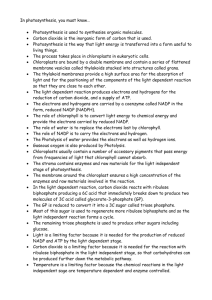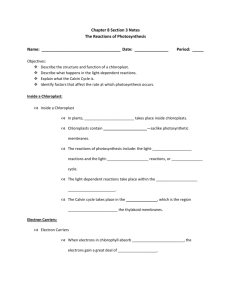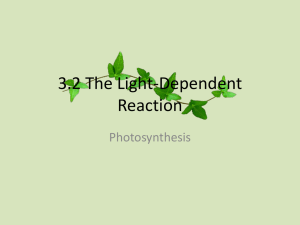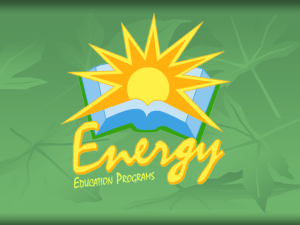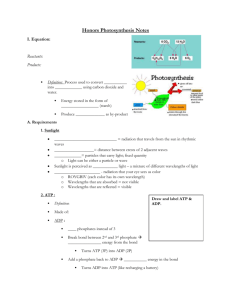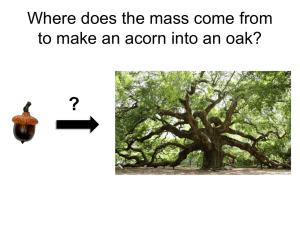Photosynthesis exam booklet
advertisement
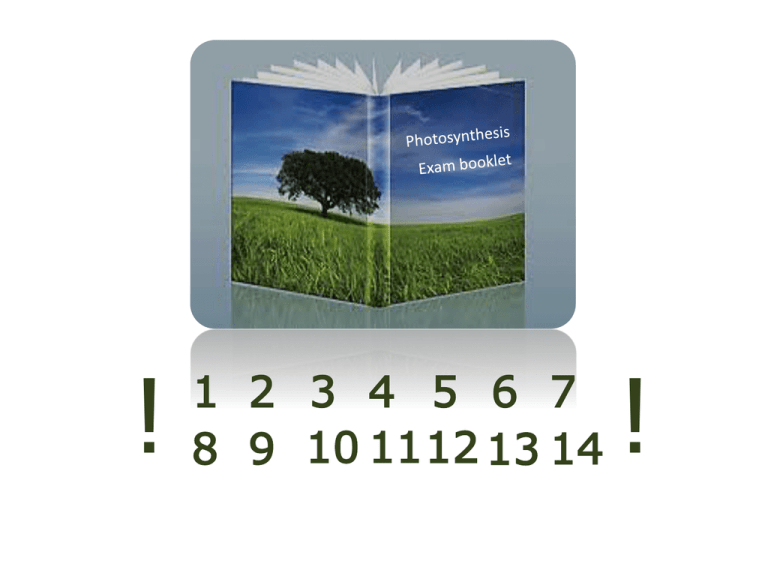
! 1 2 3 4 5 6 7 8 9 10 1112 13 14 ! Water is split into oxygen And hydrogen/ hydrogen ions Light energy raises electrons t Electrons received by photosyst ATP Provides energy Reduced NADP/ NADPH Reduces GP/ passes H to GP Electrons in chlorophyll/ photosystems are raised to higher energy level by light Electrons pass along transfer chain The energy is used to make ATP from ADP and Pi Electrons (and H+) reduce NADP H +come from photolysis They are used in the light independent stage/ Calvin cycle To convert GP to TP The reduced NADP supplies hydrogen atoms The ATP supplies energy Reduced by electrons From photolysis / chlorophyll RuBP reacts with carbon dioxide to form 2 molecules of GP Less is used to combine with carbon dioxide / Less used to form GP Carbon dioxide is used in photosynthesis / Will allow detection ATP and reduced NADP are not produced GP is not being used to form RuBP Used in respiration/ formation of starch/ cellulose Original / 100% reading light meter reading – Oxygen produced / change in oxygen concentration in unit time Oxygen is produced in light dependent reaction Light energy absorbed by chlorophyll/ excites electrons Electrons leave the chlorophyll Photolysis of water occurs Electrons replaced in chlorophyll Red light leads to more photosynthesis / more oxygen produced with red light (compared to green light) More red light absorbed (by chlorophyll) (Most) green light reflected Water is split using light e It provides electrons/ hydro Replaces the electrons lost Provides hydrogen ions for A It binds to chlorophyll molecules Prevents the release/ absorption of electrons Stops the movement of electrons down the first Less ATP produced For the Calvin cycle/ light independent reaction So less sugar produced for respiration Rate of reaction becomes Reduced NADP/ NADPH 2 Less GP formed So less TP Less RuBP regenerated/ made Less CO 2 taken up High levels of oxygen reduce the rate of photosynthesis, effect greater at higher temperatures Higher concentration means more effective competitor/ ATP Reduced NADP / NADPH O 2 produced / CO 2 taken up To ensure a high rate of photosynthesis/ so that neither factor is limiting More photosynthesis when the dark period increased from 3 to 17ms Even though amount of Products made in the light dependent system have been used up (in 17ms) Few/no trees already present Species X has high rate of photosynthesis at high light intensities Species X trees grow Species X trees will provide shade / reduce light intensity Species Z grows best/ more photosynthesis in low High concentration of CO 2 at night/ darkness No photosynthesis in dark/ light required for light dependent stage Plants respire [all the time] In the light there is a net uptake of CO 2 by plants/ rate of photosynthesis is higher than rate of respiration Decrease in CO 2 concentration Carbon dioxide combines with ribulose bisphosphate/ RuBP To produce two molecules of glycerate 3-phosphate/ GP GP is reduced to TP Which requires reduced NADP/NADPH And energy from ATP 24 2 = 1 576 = 576 0.0017 0.001 7 Radius/ diameter of the capillary tube Bubble in CO 2 Add(dissolved) hydrogen carbonate Oxygen used in respiration Oxygen would dissolve in the water Oxygen may leak from the apparatus May remain as bubble in leaf air spaces Nitrogen present in the air in the leaf/ Will leave leaf with the oxygen/ May come outthan of solution Level higher expected/ normal/ in atmosphere Plant is respiring/ produces CO 2 CO 2 has been added to the water/ present in excess Comes out of solution Intensity: less/lower light intensity in deep water pigments can absorb what Wavelength: light is notthere all wavelengths of light can penetrate/ mainly short wavelengths/ mostly blue light penetrates pigments can absorb these Light intensity Some other factor is now limiting the rate e.g. carbon dioxide concentration or 1 Rate increases when temperature increases from 15 O C to 25 O C Rate increases when carbon dioxide concentration Enzymes will (start to) denature E.g. rubisco Active site will change shape Less photolysis Less ATP produced Named step in Calvin cycle affected Increased rate of transpiration Less reflection of light More light absorbed More wavelengths of light absorbed More ATP / reduced NADP produced Temperature of leaf will increase Enzymes work more effectively Reduces limiting effect of light intensity / temperature As a control To show that light is pro Cut discs the same siz To give same surface a Cut discs from same/si To give same amount of Carry out at same tempe Temperature affects enzy Carry out repeats To calculate means/identify anomalous results Place lamp same distan To give same light int Use filters of same th To give same light inte Carry out in darkened To ensure only one wav Give CO2 in excess So that CO2 is not a li Use same volume/concent So that colour changes Put heat sink between To minimise temperature Chlorophyll a Chlorophyll reflects/does n Little/no photosynthesis/li Little/no photolysis/ split Little/no CO2 taken up Some CO2 produced in respir CO2 increases acidity/ lowe Photosynthesis is control Optimum temperature can heaters/ be controlled with ventilation/air CO2 can be increased by conditioning burning gas/paraffin CO2 will not be a will increase limiting factor/ Calvin cycle Chlorophyll a Chlorophyll b Carotene Obtaining individual organelles Xanthophyll Fucoxanthin From water Water is split in photolysis Linked to photosystem 2 Reduced NADP/ NADPH Chloroplasts retain biochemical activity Prevent activity of (lysosome) enzymes Prevent membrane/protein damage Buffer keeps pH constant No (net) water movement/ osmosis So no change in volume/ turgidity of chloroplasts blue gree n Boiled suspension: enzymes denatured change in tertiary structure/ active site no photolysis no hydrogen released DCPIP remains blue/ oxidised The End !!!!!
